Flame-throwing robot dog Thowflame Thermonator
The development of new technologies and classes of equipment is often accompanied by the creation of unusual and even strange products. Another example of this is the Thermonator robotic complex, recently presented by the American company Throwflame. It is based on a serial remote-controlled robot dog and is armed with a compact jet flamethrower. This sample looks like just another technical curiosity or advertising gimmick, but it is based on an interesting and promising concept.
Fiery new items
Last May, Throwflame (Cleveland, Ohio), a company that develops and produces flamethrowers, introduced its new product called ARC. The jet flamethrower had some interesting features and was proposed for use in a variety of fields, from agriculture to the entertainment industry. Subsequently, by way of advertising, the development company demonstrated various options for using the ARC product.
At the beginning of June, they announced a new development based on ARC - a robotic complex called Thermonator. This RTK was made by installing a flamethrower on a platform in the form of a remote-controlled robot dog of the Go1 type from the Chinese company Unitree Robotics. It was reported that such an RTK is being prepared for production, and shipments to customers will begin in the 3rd quarter of this year. However, it was not possible to meet the promised deadlines, and the product’s release to the market was delayed by six months.
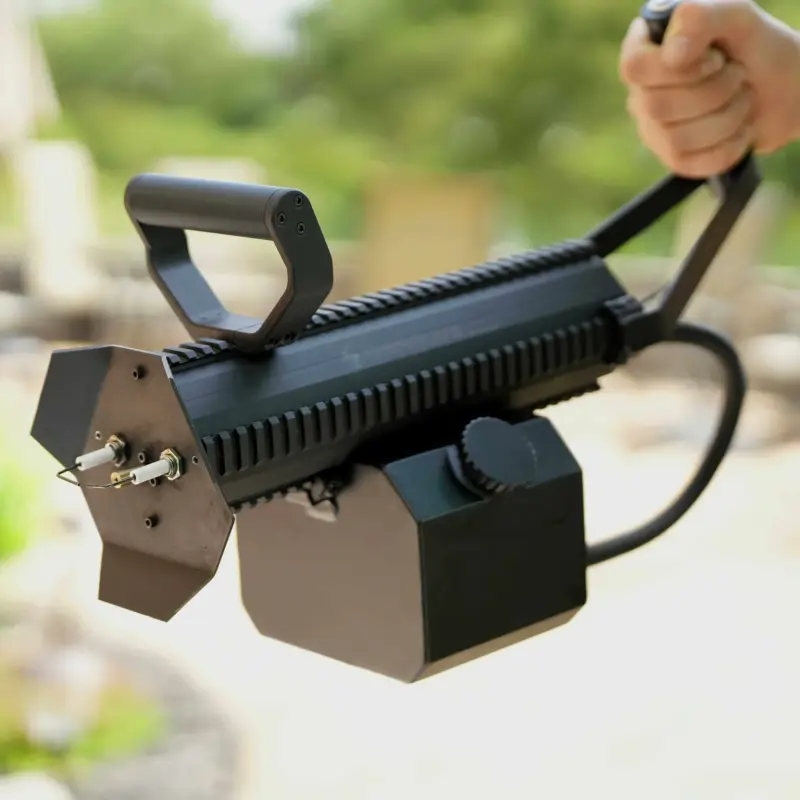
Manual ARC flamethrower
The official announcement of the Termonator as a finished product available for order took place only on April 12, 2024. At the same time, the possible reasons for the delay became clear: the complex was moved to a new base. Now the basis of the flamethrower RTK is the Go2 product from the same Unitree company. There may have been other technical or organizational reasons.
One way or another, the RTK with a flamethrower is included in the product catalog and is offered to customers. The Thermonator costs $9420. It is curious that the basic Go2 robot, depending on the configuration, costs at least three times less ($1600-2800). This pricing raises questions.
Like the ARC hand flamethrower, the Thermonator complex can be used to solve a variety of problems. A flamethrower on a self-propelled chassis can be used in agriculture to control weeds, in forest protection to combat fires, to clear snow and ice, etc. The entertainment sector has not been forgotten either.
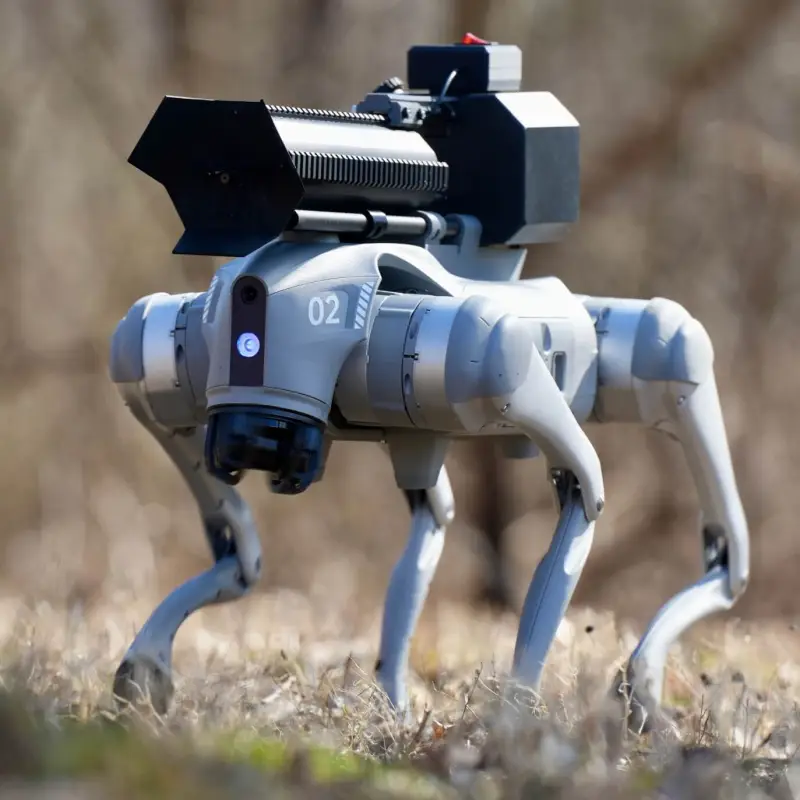
New variant of "Termonator" based on Go2
Technical features
The Go2 robot dog was used as a moving chassis for the Termonator RTK. This is a four-legged walker with a technical vision system based on a video camera and lidar, with advanced automatic control, capable of working independently or carrying any payload. Remote control is provided, and the operator gives only the most general commands, and direct control of the paw supports is carried out automatically.
Go2 has a typical “robodog” architecture. The main devices and assemblies are placed in an oblong body. It is also proposed to install additional devices on it. Four legs are movably attached to the body on the sides. Each such device has several electric motors that provide the necessary movements in several planes.
The design of the robot and its chassis allows movement forward, backward and sideways, and turns in any direction. The “dog” can jump or climb obstacles up to 160 mm high. While standing or in motion, the robot can take different poses or literally “dance”, either under the direct control of the operator or according to a preset program.
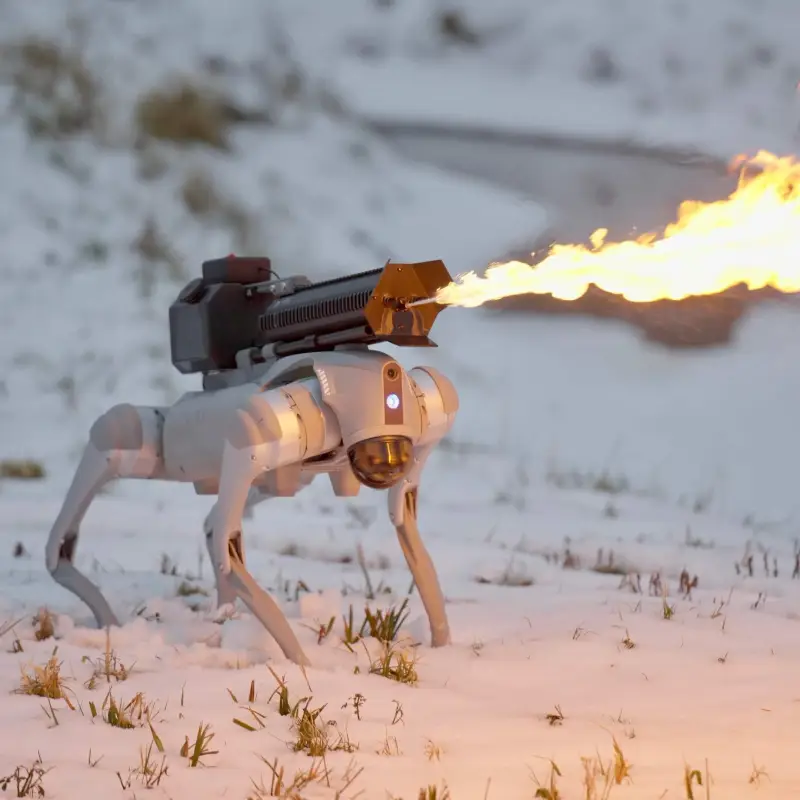
In a standing position, the robot is 700 mm long, 310 mm wide and 400 mm high. Weight including battery – approx. 15 kg. The payload is 8 kg or 10 kg in overload with a reduction in other characteristics. The battery charge lasts for 1,5-2 hours of active work with movement and maneuvering.
The Thermonator RTK uses a slightly modified ARC product. This is a compact device in a tubular housing with a length of approx. 350 mm, accommodating fuel supply means, ignition system and battery. Using a hose, the device is connected to the fire mixture tank. In the case of the Termonator, the flamethrower itself and the tank for it are placed one after the other on a common base.
The ARC flamethrower uses liquid fuel - gasoline or its mixtures with other components. The jet is released by an electric pump. The fire nozzle of the flamethrower is equipped with electrodes of a plasma ignition system. The flamethrower has limited characteristics. Thus, the mixture ejection range does not exceed 30 feet (approx. 9 m). The number of “shots” per tank refill is not specified.
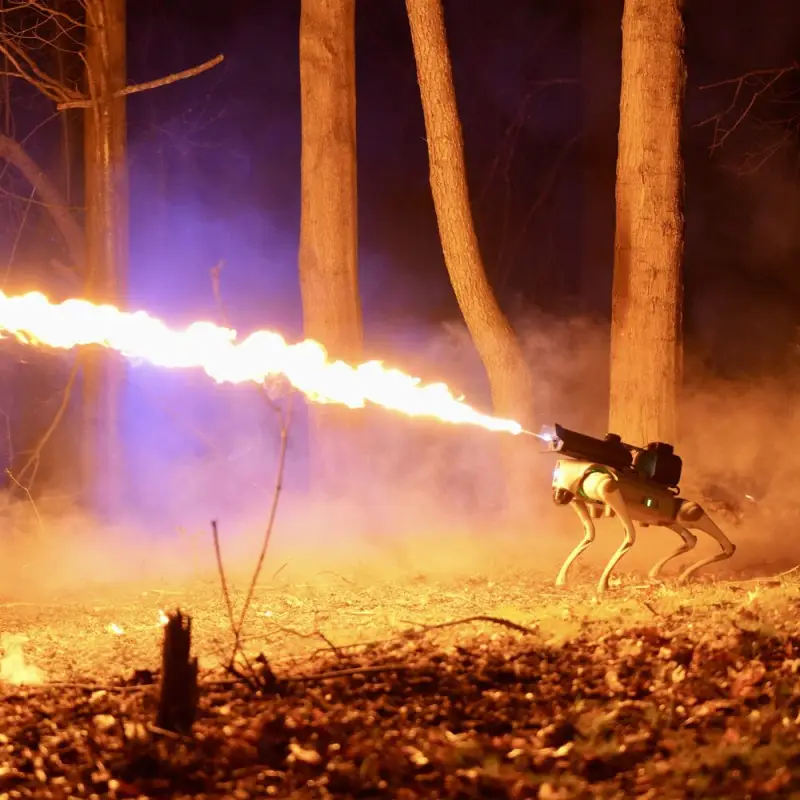
Flame throwing process
To search for a target and aim, the operator uses the robot dog’s standard heading camera. In addition, the “combat module” with a flamethrower is equipped with a laser target designator and a flashlight. The development company demonstrated the use of these products in the dark and in smoky conditions.
Interesting concept
The Throwflame company positions its Thermonator RTK as a real tool for solving practical problems. It is proposed to be used in various areas where it is necessary to burn certain objects, and also requires the ability to deliver a flamethrower to the place of work. However, there is every reason to believe that the complex will not find widespread use in its proposed role. Most likely, such products will be used solely for entertainment purposes. Of course, if potential buyers consider it advisable to purchase a not-so-cheap robot solely for fun.
However, the greatest interest in the Termonator project is not the technical aspects and not the commercial prospects. It is worth paying attention to the concept underlying it. The Trouflame company showed the fundamental possibility of equipping a robot dog with a compact flamethrower, even with limited technical and firing characteristics.
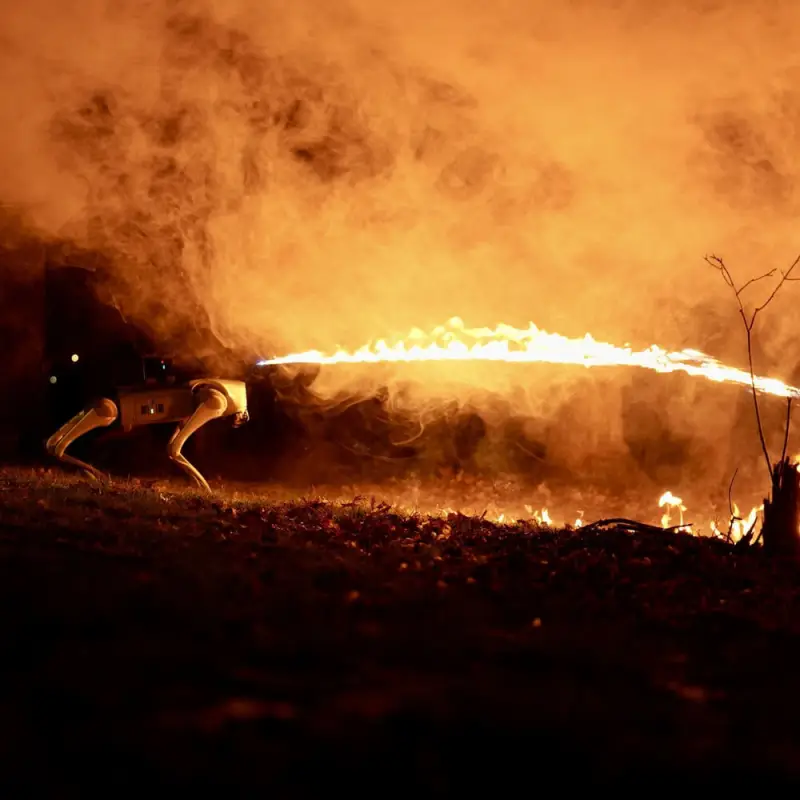
Such ideas are not new. In recent years, against the backdrop of the emergence of a number of commercial “robotic dogs,” various organizations from a number of countries have proposed several combat RTKs on a four-legged basis. Using various brackets and other devices, small arms are mounted on robots. weapon and grenade launchers of various models. Now, within the framework of this concept, a jet flamethrower has been used.
The concept of a robot dog with a weapon has several obvious advantages related to the characteristics of the platform used. A walker with automatic control has a fairly high maneuverability, and in some situations it is superior in mobility, mobility and maneuverability to wheeled and tracked chassis. At the same time, the resulting RTK has limited dimensions and weight, but is capable of carrying a fairly large payload. For example, Unitree Go2, with its own weight of 15 kg, carries up to 8-10 kg of cargo.
The robot dog simplifies the process of searching for targets and aiming combat equipment. The machine gun / grenade launcher / flamethrower is installed as a forward weapon, which allows aiming using a standard nose camera and by moving the entire robot. This eliminates the need for separate optical means and weapon control drives.
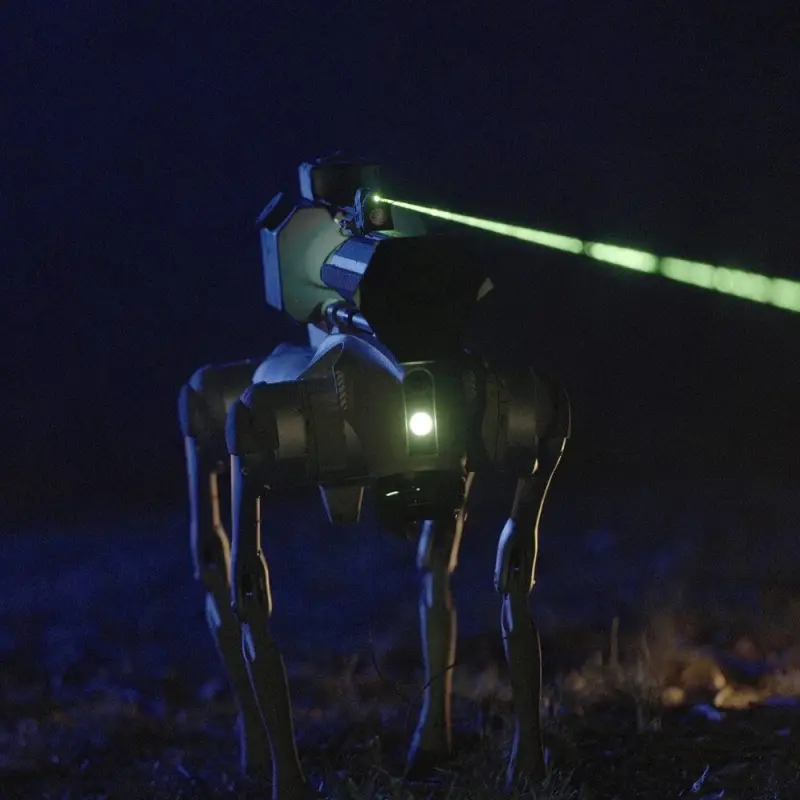
Operation of RTK in the dark. A laser pointer is used
However, four-legged RTKs with weapons have a number of obvious disadvantages. First of all, this is the excessive complexity of the design and high cost. A tracked or wheeled platform of similar dimensions with the same load capacity will be much simpler and cheaper to manufacture and operate. Advantages of this kind can offset the lag in cross-country ability and mobility, and also justify the use of a full-fledged combat module.
In addition, there is the experience factor. RTKs on traditional chassis with combat modules of a standard appearance have been developed for quite a long time, and the industry has gained extensive experience in this area. Fighting “robotic dogs” are still a rare phenomenon and are not popular among developers. Experience in this area is still limited, which negatively affects the pace of its development.
Advertising and Experience
What future awaits RTK Thermonator is still unknown. However, we can already say that this product was able to solve two important problems. It showed the fundamental possibility of installing a jet flamethrower on a robot dog, and also attracted public attention to the development company. Perhaps, after such advertising, Trowflame will be able to increase sales of its main products and even find customers for a flamethrower robotic complex.
It can be assumed that the ideas of the Termonator project will nevertheless be developed and will be implemented in the form of new products from different companies. This work will contribute to the further development of the entire field of four-legged combat robots, and, perhaps, someday will lead to the emergence of a real combat-ready RTK and its adoption. But so far we are talking only about interesting experiments without obvious practical prospects.
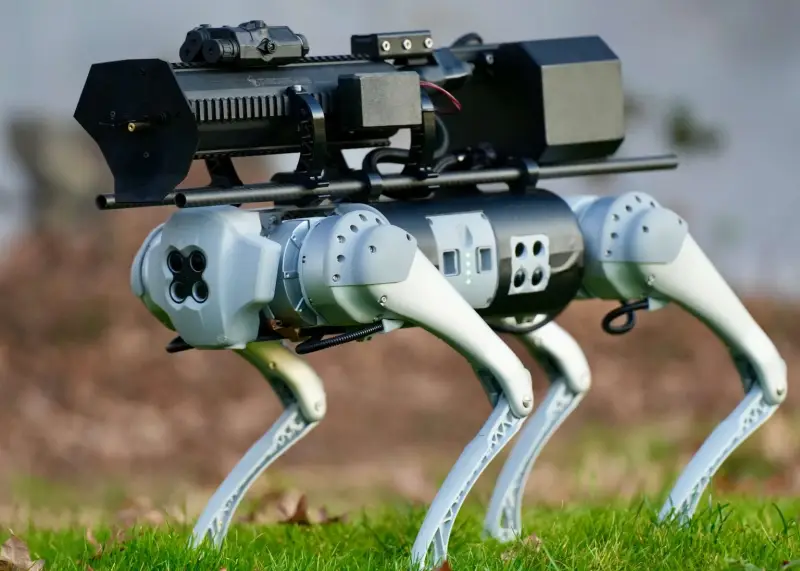
Information